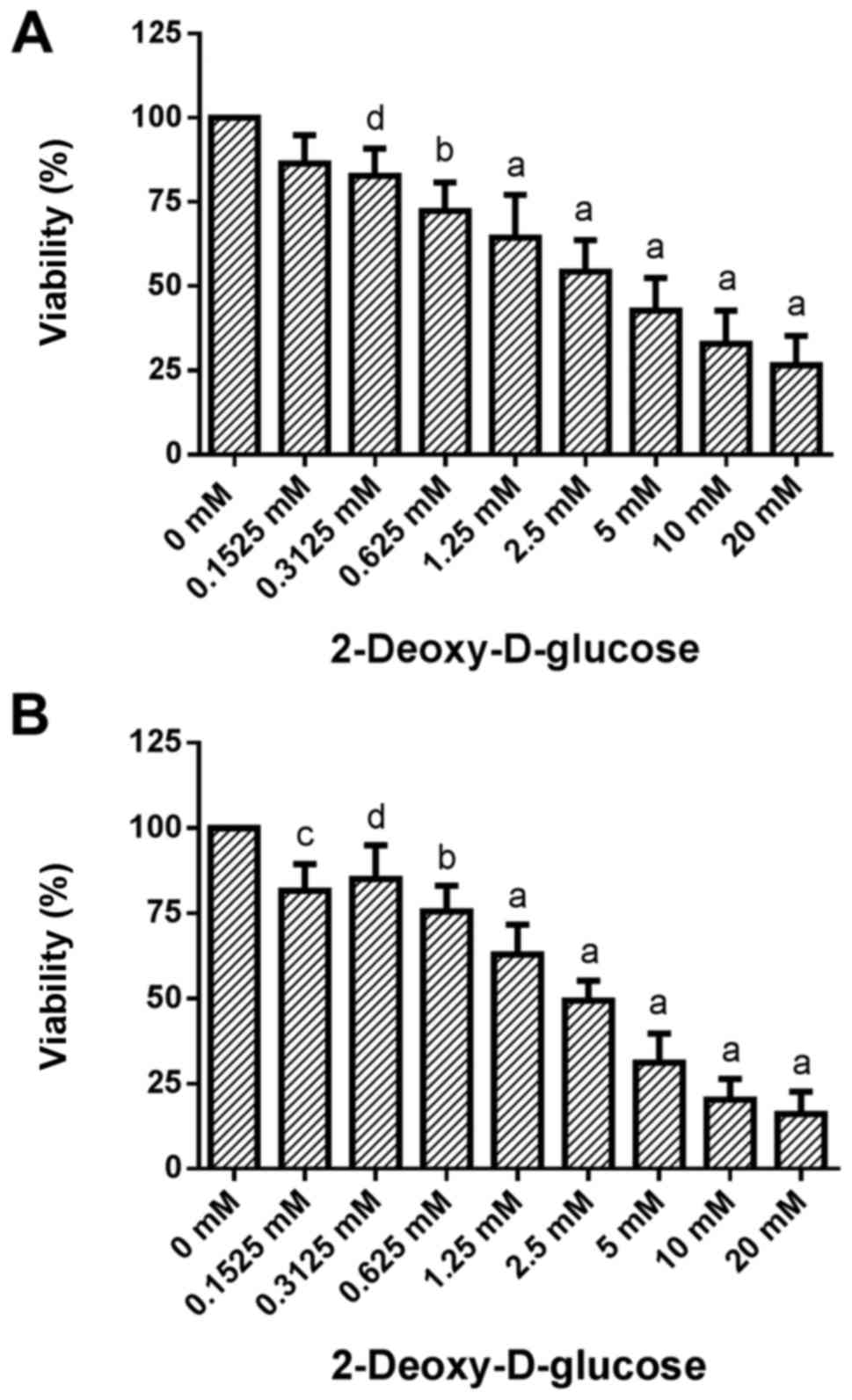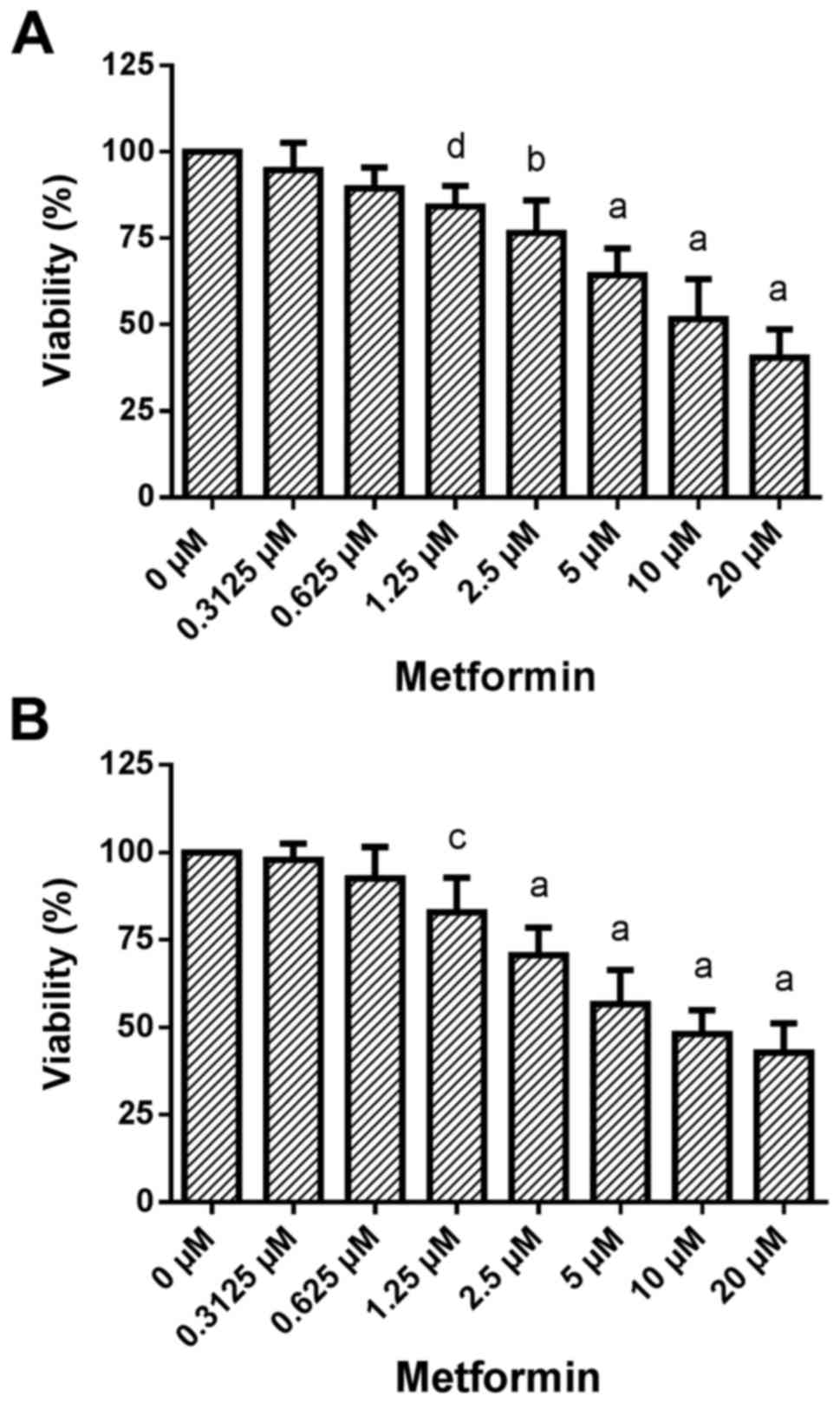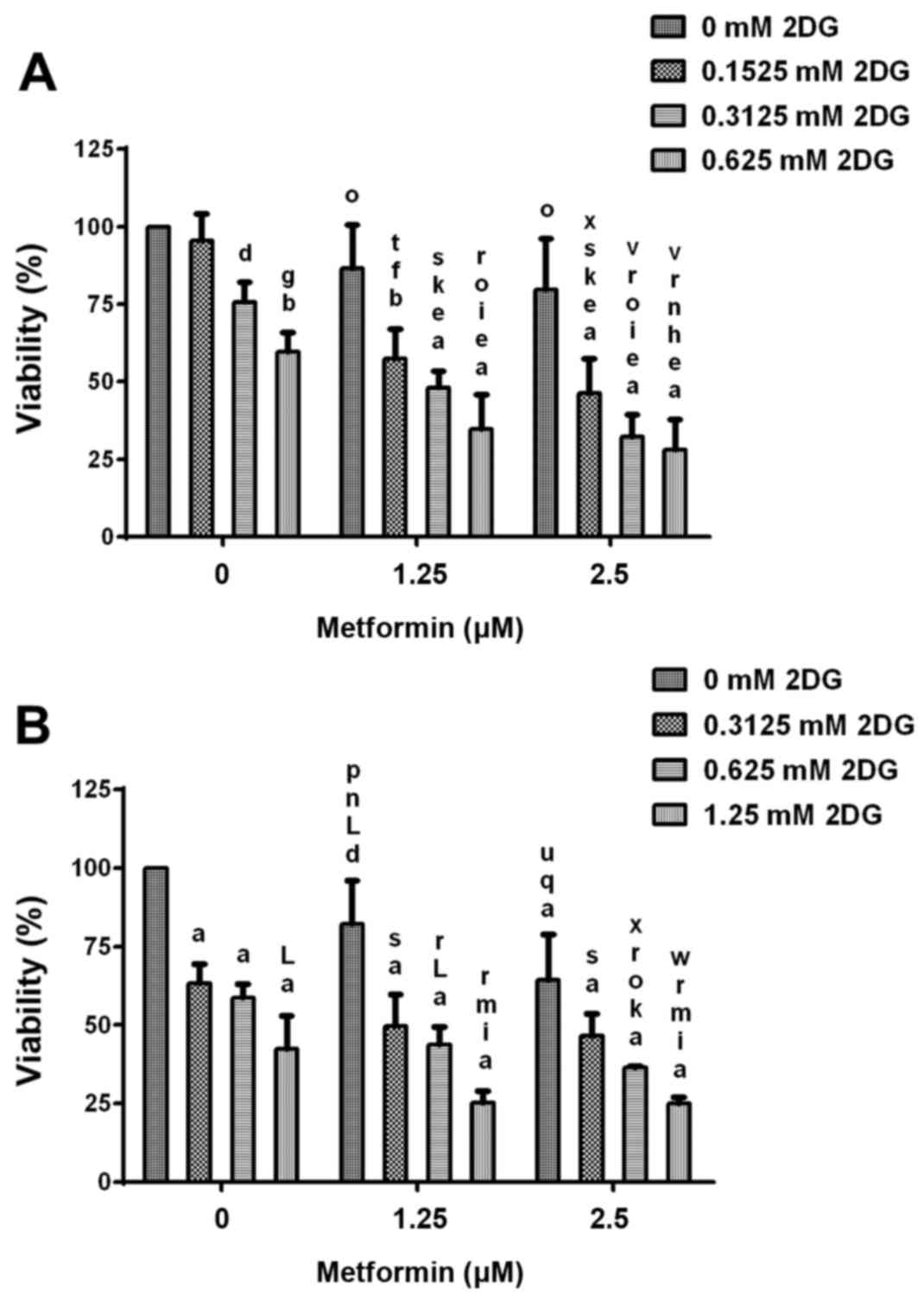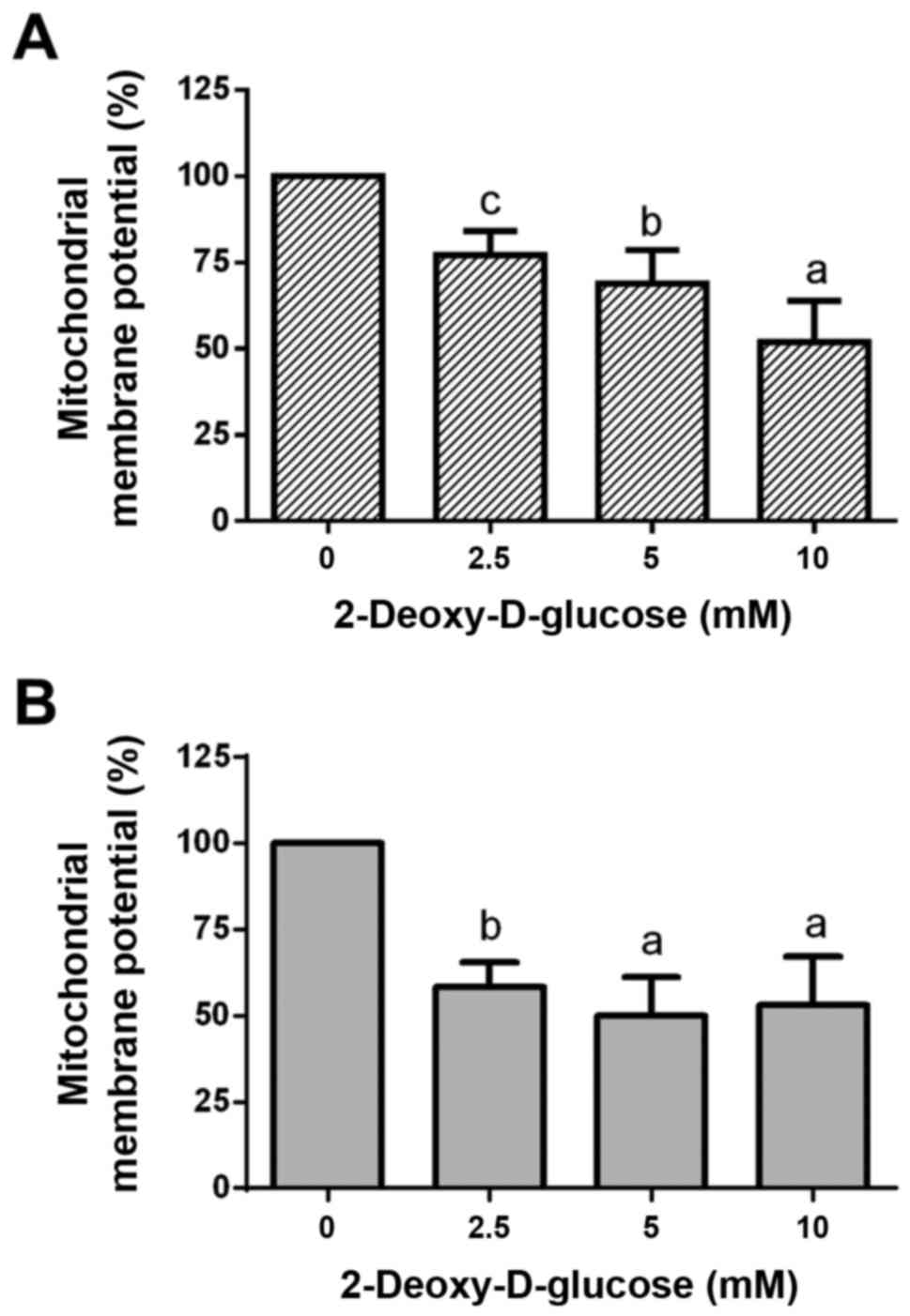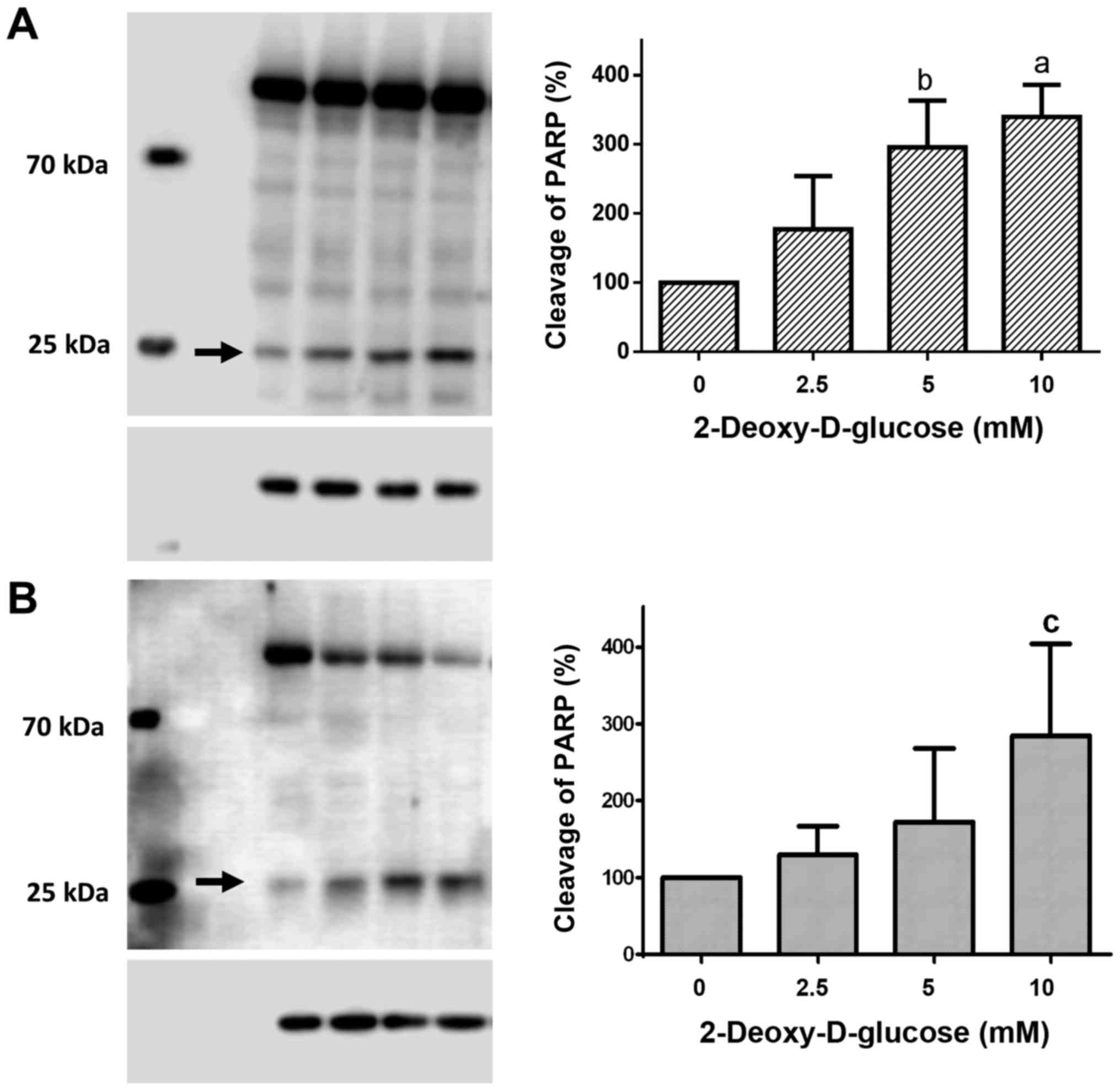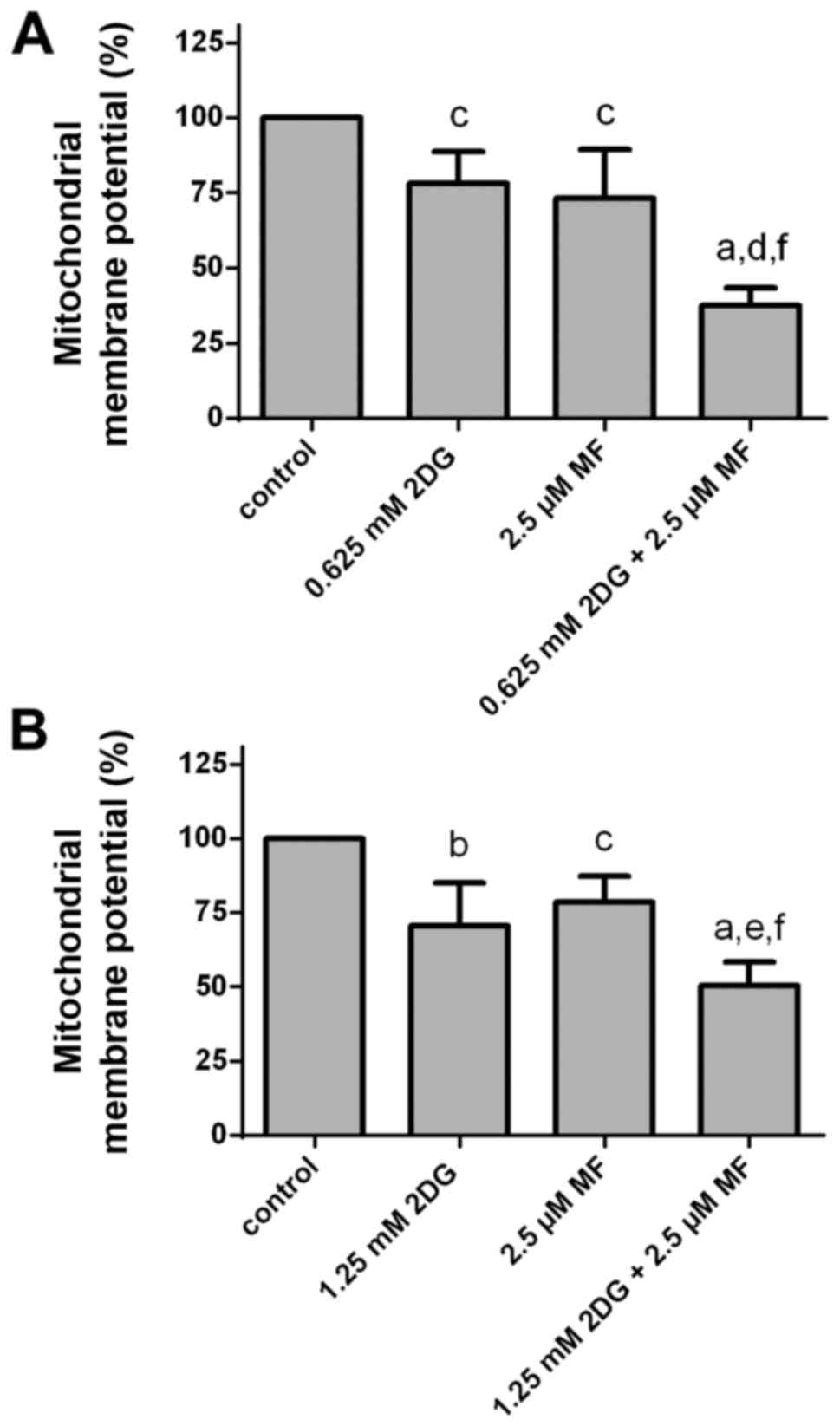Co-treatment of breast cancer cells with pharmacologic doses of 2-deoxy-D-glucose and metformin: Starving tumors
- Authors:
- Published online on: March 6, 2017 https://doi.org/10.3892/or.2017.5491
- Pages: 2418-2424
Abstract
Introduction
Therapeutic selectivity is one of the most important criteria in the therapy of cancer. In order to achieve effective destruction of cancer tissue without side-effects, it is important to consider the biological differences between normal and cancer cells. One change that occurs in malignant cells is the increase of glycolysis for energy production regardless of the availability of oxygen. This is known as the Warburg effect (1). In addition, in many tumors glucose transporter 1 (GLUT1) is overexpressed resulting in increased glucose uptake (2). The exact molecular mechanisms that lead to these metabolic changes are not yet completely understood, yet increased GLUT1 expression and the central role of glycolysis in tumor cells represent an attractive target of attack for selective tumor therapy (3). Due to the dependence of tumor cells on glycolysis, 2-geoxy-D-glucose (2DG) has been considered as a potential anticancer agent. 2DG is a glucose analog, which leads to inhibition of glycolysis and a decrease in ATP production resulting in induction of apoptosis through activation of caspase-3 in solid tumors (4–8). Combination of chemotherapeutic agents including GnRH receptor-targeted chemotherapy using AEZS-108 (AN-152) and 2DG has been successfully tested (9).
Metformin (1,1-dimethylbiguanide hydrochloride) is a well-established drug used for the treatment of type 2 diabetes. It acts by reducing insulin resistance via different mechanisms, including increased glycogen synthesis, enhanced insulin receptor tyrosine kinase activity, and an increase in glucose transporter 4 (GLUT4) recruitment and activity (10). In addition, metformin affects fasting plasma insulin levels, resulting in the reduction in glucose concentrations in the blood (11). Different preclinical studies have demonstrated the anti-neoplastic effects of metformin in animal models of different tumor entities including cancers of the breast (12–17). The proposed mechanisms of these antitumor effects include an indirect, insulin-dependent pathway by reduction of serum insulin levels, direct modulation of cellular protein synthesis, and direct growth inhibition through effects in the phosphatidylinositide 3-kinase (PI3K)/protein kinase B (PKB and Akt)/AMP-activated protein kinase (AMPK) signaling pathway (18,19).
Increased glycolysis for energy production is necessary for the survival of tumor cells, and thus represents a selective therapeutic target. In the present study, we showed that the glycolytic phenotype of human breast cancer cells can be targeted for therapeutic intervention. We aimed to ascertain whether treatment with well-tolerable doses of 2DG can reduce the viability of triple-negative breast cancer (TNBC) cells in vitro. In addition, we tested whether the antitumor efficacy of glycolysis inhibition by 2DG can be enhanced by co-treatment with pharmacologic doses of metformin.
Materials and methods
Cell lines and culture conditions
The TNBC cell lines HCC1806 and MDA-MB-231 were obtained from the American Type Culture Collection (ATCC; Manassas, Virginia, USA). In order to guarantee the identity of the cell lines over the years, the cells were expanded after purchase and aliquots were stored in liquid nitrogen. Every half year a new frozen stock was opened and expanded to carry out the experiments. The cells were cultured at 37̊C in a humidified atmosphere of 5% CO2 in air as previously described (20–22).
Chemicals
2DG and metformin were purchased from Sigma Chemical Company (Deisenhofen, Germany).
Viability assay
Five hundred cells/well were plated into 96-well plates (Falcon, Heidelberg, Germany) in 100 µl Dulbeccos modified Eagles medium (DMEM)/5% fetal calf serum (FCS; Biochrom GmbH, Berlin, Germany) without phenol red, 2 mM glutamine, 50 U/ml penicillin/streptomycin, 2.5 µg/ml amphotericin B and 1:100 non-essential amino acids. After cell attachment, 100 µl medium, 100 µl 2DG/medium solution, 100 µl metformin/medium solution or 100 µl solution with 2DG in combination with metformin was added to the wells in six replicates and incubated for 96 h at 37̊C in 5% CO2. Final concentrations of 2DG, metformin and the combination of both agents are provided in the Results section. Cell number was determined by a colorimetric assay using Alamar Blue (BioSource, Solingen, Germany). The optical density (OD) of the reduced dye was assessed at 570 vs. 630 nm after 4 h at 37̊C.
Mitochondrial membrane potential
Cells were treated for 48 h without or with 2DG, metformin or the combination of both agents. Final concentrations of 2DG, metformin and the combination of both agents are provided in the Results section. Then the cells were washed once with phosphate-buffered saline (PBS) and mitochondrial membrane potential was measured using the JC-1 mitochondrial membrane potential detection kit according the manufacturers instructions (Biotium, Hayward, CA, USA).
Western blot analysis of cleaved PARP
Cells were treated for 48 h without or with 2DG or metformin or the combination of both. Final concentrations of 2DG, metformin and the combination of both agents are provided in the Results section. Then, the cells were detached with 0.5 g trypsin (Biochrom) and 5 mmol EDTA in 1 l PBS/BSA. The pellets were washed twice with PBS and resuspended with CelLytic™ buffer containing protease inhibitors (both from Sigma). Equal amounts of protein/sample were used and diluted to equal volumes with Laemmli-buffer. The cell lysates were separated on SDS-PAGE (15%, ProSieve® 50 Gel Solution; Cambrex, Verviers, Belgium) under reducing conditions and transferred to nitrocellulose membranes (Hybond ECL; GE Healthcare Europe, Munich, Germany). The nitrocellulose membranes were blocked with 5% instant skimmed milk powder, spray-dried (Naturaflor, Töpfer GmbH, Dietmannsried, Germany) in Tris-buffered saline and Tween-20 (TBST) (137 mM NaCl, 2.7 mM KCL, 0.1% Tween-20, 25 mM Tris/Cl, pH 7.4) for 1 h at room temperature (RT), washed with TBST and then incubated at 4̊C overnight with rabbit anti-human active caspase-3 polyclonal antibody (BD Pharmingen, Heidelberg, Germany) in a 1:5,000 dilution in TBST and then, following washings, incubated at RT with horseradish peroxidase-conjugated anti-rabbit IgG (GE Healthcare Europe) at an 1:10,000 dilution in TBST for 1 h. After washings, specifically bound antibody was detected using the SuperSignal™ West Femto Maximum Sensitivity chemiluminescence substrate (Thermo Scientific, Rockford, IL, USA). For quantification, the bands were analyzed using a C-DiGit Blot Scanner (Li-COR, Lincoln, NE, USA).
Statistical analysis
All experiments were repeated at least three times with different passages of the respective cell lines. The data were tested for significant differences by one-way analysis (Figs. 1–4, and 6) of variance or two-way analysis of variance (Fig. 5) followed by Tukey's multiple comparisons test for comparison of individual groups, after a Bartlett test had shown that variances were homogenous using GraphPad Prism 6.01 software (GraphPad Software Inc., La Jolla, CA, USA).
Results
Dose-response effects of 2DG treatment on cell viability
Treatment of HCC1806 (Fig. 1A) and MDA-MB-231 (Fig. 1B) human breast cancer cells with increasing concentrations of 2DG (0.1525, 0.3125, 0.625, 1.25, 2.5, 5, 10 and 20 mM) for 96 h resulted in a significant dose-dependent reduction in viability.
A slight decrease in the number of living HCC1806 cells to 86.4±8.4 (SD)% of the control (C=100%) was observed at 0.1525 mM concentration of 2DG. At a 0.3125 mM concentration of 2DG the decrease in cell number became significant [82.8±8.1% of the control (C=100%; P<0.05)]. A concentration of 0.625 mM of 2DG resulted in a significant reduction in living HCC1806 cells to 72.4±8.4% of the control (C=100%; P<0.001). At 1.25, 2.5, 5 and 10 mM, as well as at 20 mM concentrations of 2DG a decrease in living HCC1806 cells to 64.5±12.7, 54.4±9.3, 42.8±9.7, 32.8±9.9 and 26.5±8.8% of the control (C=100%; P<0.0001 in all concentrations) was observed, respectively.
When the MDA-MB-231 cells were treated with 2DG for 96 h the number of living cells was dose-dependently reduced vs. the control (C=100%) as follows: 0.1525 mM, 81.6±7.9% (P<0.01); 0.3125 mM, 85.0±9.9% (P<0.05); 0.625 mM, 75.6±7.5% (P<0.001); 1.25 mM, 63.0±8.8% (P<0.0001); 2.5 mM, 49.4±5.9% (P<0.0001); 5 mM, 31.2±8.5% (P<0.0001); 10 mM, 20.3±6.1% (P<0.0001); 20 mM, 16.1±6.5% (P<0.0001).
Dose-response effects of 2DG treatment on mitochondrial membrane potential
Treatment of HCC1806 (Fig. 2A) and MDA-MB-231 (Fig. 2B) human breast cancer cells with 2.5, 5 and 10 mM of 2DG for 48 h resulted in a significant dose-dependent reduction in mitochondrial membrane potential (ΔΨm).
At a 2.5 mM concentration of 2DG, mitochondrial membrane potential in the HCC1806 cells was significantly decreased to 77.1±7.0% of the control (C=100%; P<0.01). A concentration of 5 mM of 2DG resulted in a significant reduction in mitochondrial membrane potential to 68.9±9.7% of the control (C=100%; P<0.001). At a 10 mM concentration of 2DG, a significant reduction in mitochondrial membrane potential to 51.9±12.0% of the control (C=100%; P<0.0001) was observed.
When MDA-MB-231 cells were treated with 2DG for 48 h, mitochondrial membrane potential was dose-dependently reduced vs. the control (C=100%) as follows: 2.5 mM, 58.3±7.2% (P<0.001); 5 mM, 50.1±11.0% (P<0.0001); 10 mM, 53.2±14.0% (P<0.0001).
Dose-response effects of 2DG treatment on PARP cleavage
Treatment of HCC1806 (Fig. 3A) and MDA-MB-231 (Fig. 3B) human breast cancer cells with 2.5, 5 and 10 mM of 2DG for 48 h resulted in a significant dose-dependent increase in cleaved PARP protein.
Following treatment with a 2.5 mM concentration of 2DG for 48 h, the level of cleaved PARP protein in the HCC1806 cells was increased to 177.3±76.6% of the control (C=100%). A concentration of 5 mM of 2DG resulted in a significant increase in PARP cleavage to 295.8±67.3% of the control (C=100%; P<0.01). At a 10 mM concentration of 2DG, a significant increase in cleaved PARP protein to 339.5±46.5% of the control (C=100%; P<0.001) was observed.
When MDA-MB-231 cells were treated with 2DG for 48 h, cleaved PARP protein was dose-dependently increased vs. the control (C=100%) as follows: 2.5 mM, 129.6±37.3%; 5 mM, 172.1±95.6%; 10 mM, 284.5±119.4% (P<0.05).
Dose-response effects of metformin treatment on cell viability. Treatment of HCC1806 (Fig. 4A) and MDA-MB-231 (Fig. 4B) human breast cancer cells with increasing concentrations of metformin (0.3125, 0.625, 1.25, 2.5, 5, 10 and 20 µM) for 96 h resulted in a significant dose-dependent reduction in viability.
A very slight decrease in the number of living HCC1806 cells to 94.8±7.9% of the control (C=100%) was observed at 0.3125 µM concentration of metformin. A concentration of 0.625 µM of metformin resulted in a slight decrease in cell number to 89.4±6.0% of the control (C=100%). At a 1.25 µM concentration of metformin, the decrease in cell number became significant [84.2±5.9% of the control (C=100%; P<0.05)]. A concentration of 2.5 µM of metformin resulted in a significant reduction in living HCC1806 cells to 76.6±9.5% of the control (C=100%; P<0.001). At 5 and 10 µM, as well as at 20 µM concentrations of metformin a decrease in living HCC1806 cells to 64.3±7.7, 51.6±11.6 and 40.5±8.1% of the control (C=100%; P<0.0001 in all concentrations) was observed, respectively.
When MDA-MB-231 cells were treated with metformin for 96 h the number of living cells was dose-dependently reduced vs. the control (C=100%) as follows: 0.3125 µM, 98.0±4.5%; 0.625 µM, 92.5±9.0%; 1.25 µM, 82.9±9.9% (P<0.01); 2.5 µM, 70.6±7.8% (P<0.0001); 5 µM, 56.7±9.7% (P<0.0001); 10 µM, 48.1±6.8% (P<0.0001); 20 µM, 42.8±8.3% (P<0.0001).
Cell viability after treatment with 2DG alone and in combination with metformin
During treatment of HCC1806 breast cancer cells with 2.5, 5 and 10 mM concentrations of 2DG in combination with 2.5 and 5 µM concentrations of metformin, a classic dose-response effect was not shown (data not shown), indicating that at these concentrations the maximal effects in this cell line were achieved. Therefore, experiments using lower concentrations of 2DG and metformin were performed (Fig. 5). Treatment of HCC1806 human breast cancer cells (Fig. 5A) without or with increasing concentrations (0.1525, 0.3125 and 0.625 mM) of 2DG and without or with increasing concentrations (1.25 and 2.5 µM) of metformin for 96 h resulted in a significant dose-dependent reduction in cell viability. Co-treatment with both agents resulted in a significantly dose-dependent higher reduction of viability than 2DG or metformin alone. At the highest concentrations of 2DG (0.625 mM) and metformin (2.5 µM), viability of the HCC1806 cells was reduced to 28.1±9.7% of the control (C=100%; P<0.0001). Treatment with 0.625 mM 2DG alone resulted in a decrease in viability to 59.5±6.3% of the control (C=100%; P<0.001). After treatment with metformin alone (2.5 µM), viability was reduced to 79.7±16.4% of the control (C=100%).
Treatment of MDA-MB-231 human breast cancer cells (Fig. 5B) without or with increasing concentrations (0.3125, 0.625 and 1.25 mM) of 2DG and without or with increasing concentrations (1.25 and 2.5 µM) of metformin for 96 h resulted in a significant dose-dependent reduction in cell number. Co-treatment with both agents resulted in a significantly higher dose-dependent reduction in cell number than 2DG or metformin alone. At the highest concentrations of 2DG (1.25 mM) and metformin (2.5 µM), the viability of the HCC1806 cells was reduced to 25.1±2.0% of the control (C=100%; P<0.0001). Treatment with 1.25 mM 2DG alone resulted in a decrease in viability to 42.5±10.5% of the control (C=100%; P<0.0001). After treatment with metformin alone (2.5 µM), viability was reduced to 64.5±14.4% of the control (C=100%; P<0.0001).
Effects of 2DG alone and in combination with metformin on mitochondrial membrane potential
Treatment of HCC1806 (Fig. 6A) and MDA-MB-231 (Fig. 6B) human breast cancer cells with 2DG (HCC1806, 0.625 mM; MDA-MB-231, 1.25 mM) or with metformin (2.5 µM) for 48 h resulted in a reduction in mitochondrial membrane potential (ΔΨm). Co-treatment with both agents resulted in a significant higher reduction in mitochondrial membrane potential than with 2DG or metformin alone.
After treatment of HCC1806 cells with a 0.625 mM concentration of 2DG for 48 h, the mitochondrial membrane potential was significantly decreased to 78.2±10.6% of the control (C=100%; P<0.05). A concentration of 2.5 µM of metformin resulted in a significant reduction in mitochondrial membrane potential to 73.3±16.1% of the control (C=100%; P<0.05). At 0.625 mM concentration of 2DG in combination with 2.5 µM concentration of metformin, a significant reduction in mitochondrial membrane potential to 37.5±6.0% of the control (C=100%; P<0.0001 vs. control; P<0.001 vs. 2DG alone; P<0.01 vs. metformin alone) was observed.
When MDA-MB-231 cells were treated with 2DG (1.25 mM) for 48 h, the mitochondrial membrane potential was significantly reduced to 70.6±14.4% of the control (C=100%; P<0.01). A concentration of 2.5 µM of metformin resulted in a significant decrease in mitochondrial membrane potential to 78.5±8.7% of the control (C=100%; P<0.05). At 1.25 mM concentration of 2DG in combination with 2.5 µM concentration of metformin a significant reduction in mitochondrial membrane potential to 50.3±8.0% of the control (C=100%; P<0.0001 vs. control; P<0.05 vs. 2DG alone; P<0.01 vs. metformin alone) was observed.
Discussion
In the present study, we analyzed the combination of 2DG and metformin, two drugs which target two key sources of cell energy and may represent a major advantage over classic chemotherapies alone or in combination with 2DG. Our results showed that inhibition of glycolysis using 2DG significantly reduced the viability of the human breast cancer cells in a dose-dependent manner. In addition, anti-diabetic drug metformin showed significant and dose-dependent antitumor activity in the human breast cancer cells. 2DG in combination with metformin led to a significant higher reduction in viability than 2DG or metformin alone. After co-treatment with 0.625 mM 2DG and 2.5 µM metformin, HCC1806 cell viability was reduced by at least 72%. At 0.625 mM concentration of 2DG and 2.5 µM concentration of metformin, cell viability of the MDA-MB-231 cells was reduced by at least 64%. Even lower concentrations of 2DG and metformin resulted in an impressive decrease in cell viability. These concentrations are below those achieved with doses normally administered in human treatment. In a dose-escalation trial with 2DG orally administered once daily, 63 mg/kg was found to be a clinically well-tolerable dose (23). The median maximum plasma concentration of 2DG at 63 mg/kg was 116 µg/ml (0.7 mM) (23). A typical treatment dose of metformin is 1,000–2,500 mg given twice daily, resulting in steady state plasma concentrations of ~1 µg/ml (7.7 µM) reached within 24–48 h (24,25). During controlled clinical trials, maximum metformin plasma levels did not exceed 5 µg/ml (38.7 µM), even at maximum doses (24). Higher concentrations of 2DG (>1.25 mM) in our co-treatment settings resulted in a further decrease in cell viability in vitro. However, these higher concentrations may not be well tolerated in patients.
Treatment of the breast cancer cells with 2DG resulted in a strong induction of apoptosis. Co-treatment with 2DG in combination with metformin induced a significantly higher decrease in viability and a significant higher increase in apoptosis than treatment with the respective single substances. Our observations regarding the antitumor effectiveness of both substances alone and in combination are in agreement with the results of other groups. Zhang and Aft demonstrated the antiproliferative effects of 2DG in cell lines of different tumor entities including breast cancer (26). In addition, our results confirm data shown by Cheong et al, indicating that co-treatment with 2DG and metformin is effective against breast cancer cell lines (27). However, Cheong et al used concentrations of 2DG (4 mM) and metformin (5 mM), which are higher than well-tolerated concentrations or plasma accessible concentrations in human beings (23–25). In another publication, a combination of 2DG (1 mM) and metformin (1 and 5 mM) was successfully tested in prostate cancer cells using metformin concentrations which are higher than those accessible in blood plasma of human beings (28).
Doses much greater than the pharmacologic concentration of metformin inhibit mitochondrial complex I and induce cell cycle arrest (29–33). Pharmacologic metformin concentrations activate AMP-activated protein kinase (AMPK) and inhibit expression of gluconeogenic genes. In addition, pharmacologic concentrations of metformin inhibit glycerol-3-phosphate dehydrogenase (GPDH) in mitochondria resulting in a decrease in gluconeogenesis (34). The glucose analog 2DG inhibits glycolysis and induces autophagy (35–37). Co-treatment with 2DG and metformin resulted in significant cell death, which is associated with a marked decrease in intracellular ATP concentration, prolonged AMPK activation, and sustained autophagy (27). However, the marked antitumor effects of the combination of 2DG and metformin have the clinical advantage of inducing no negative side-effects. Only lactic acidosis was reported to be a very rare side-effect in metformin-treated patients (38).
2DG as a glycolysis inhibitor represents an attractive option for therapy including combination therapies. Since increased glycolysis occurs in malignant cells, 2DG acts specifically in tumor tissue. Therapy utilizing both specific inhibition of glycolysis using 2DG, and the antitumor activity of metformin appears to be valuable as an effective strategy for the treatment of all inoperable, chemotherapy-resistant or recurring breast cancers and should be further evaluated.
Acknowledgements
We thank Sonja Blume for the excellent technical assistance. The present study was supported by a grant from the Deutsche Krebshilfe, Dr Mildred Scheel Stiftung (no. 111027).
References
|
Warburg O: The Metabolism of Tumors. Arnold Constable; London: pp. 254–270. 1930 | |
|
Yamamoto T, Seino Y, Fukumoto H, Koh G, Yano H, Inagaki N, Yamada Y, Inoue K, Manabe T and Imura H: Over-expression of facilitative glucose transporter genes in human cancer. Biochem Biophys Res Commun. 170:223–230. 1990. View Article : Google Scholar : PubMed/NCBI | |
|
Pelicano H, Martin DS, Xu RH and Huang P: Glycolysis inhibition for anticancer treatment. Oncogene. 25:4633–4646. 2006. View Article : Google Scholar : PubMed/NCBI | |
|
Kaplan O, Navon G, Lyon RC, Faustino PJ, Straka EJ and Cohen JS: Effects of 2-deoxyglucose on drug-sensitive and drug-resistant human breast cancer cells: Toxicity and magnetic resonance spectroscopy studies of metabolism. Cancer Res. 50:544–551. 1990.PubMed/NCBI | |
|
Laszlo J, Humphreys SR and Goldin A: Effects of glucose analogues (2-deoxy-D-glucose, 2-deoxy-D-galactose) on experimental tumors. J Natl Cancer Inst. 24:267–281. 1960.PubMed/NCBI | |
|
Aft RL, Zhang FW and Gius D: Evaluation of 2-deoxy-D-glucose as a chemotherapeutic agent: Mechanism of cell death. Br J Cancer. 87:805–812. 2002. View Article : Google Scholar : PubMed/NCBI | |
|
Bell SE, Quinn DM, Kellett GL and Warr JR: 2-Deoxy-D-glucose preferentially kills multidrug-resistant human KB carcinoma cell lines by apoptosis. Br J Cancer. 78:1464–1470. 1998. View Article : Google Scholar : PubMed/NCBI | |
|
Lee YJ, Galoforo SS, Berns CM, Tong WP, Kim HR and Corry PM: Glucose deprivation-induced cytotoxicity in drug resistant human breast carcinoma MCF-7/ADR cells: Role of c-myc and bcl-2 in apoptotic cell death. J Cell Sci. 110:681–686. 1997.PubMed/NCBI | |
|
Reutter M, Emons G and Gründker C: Starving tumors: Inhibition of glycolysis reduces viability of human endometrial and ovarian cancer cells and enhances antitumor efficacy of GnRH receptor-targeted therapies. Int J Gynecol Cancer. 23:34–40. 2013. View Article : Google Scholar : PubMed/NCBI | |
|
Giannarelli R, Aragona M, Coppelli A and Del Prato S: Reducing insulin resistance with metformin: The evidence today. Diabetes Metab. 29:6S28–6S35. 2003. View Article : Google Scholar : PubMed/NCBI | |
|
Nathan DM, Buse JB, Davidson MB, Ferrannini E, Holman RR, Sherwin R and Zinman B: American Diabetes Association; European Association for Study of Diabetes: Medical management of hyperglycemia in type 2 diabetes: A consensus algorithm for the initiation and adjustment of therapy: A consensus statement of the American Diabetes Association and the European Association for the Study of Diabetes. Diabetes Care. 32:193–203. 2009. View Article : Google Scholar : PubMed/NCBI | |
|
Anisimov VN, Berstein LM, Egormin PA, Piskunova TS, Popovich IG, Zabezhinski MA, Kovalenko IG, Poroshina TE, Semenchenko AV, Provinciali M, et al: Effect of metformin on life span and on the development of spontaneous mammary tumors in HER-2/neu transgenic mice. Exp Gerontol. 40:685–693. 2005. View Article : Google Scholar : PubMed/NCBI | |
|
Anisimov VN, Egormin PA, Piskunova TS, Popovich IG, Tyndyk ML, Yurova MN, Zabezhinski MA, Anikin IV, Karkach AS and Romanyukha AA: metformin extends life span of HER-2/neu transgenic mice and in combination with melatonin inhibits growth of transplantable tumors in vivo. Cell Cycle. 9:188–197. 2010. View Article : Google Scholar : PubMed/NCBI | |
|
Ben Sahra I, Laurent K, Loubat A, Giorgetti-Peraldi S, Colosetti P, Auberger P, Tanti JF, Le Marchand-Brustel Y and Bost F: The antidiabetic drug metformin exerts an antitumoral effect in vitro and in vivo through a decrease of cyclin D1 level. Oncogene. 27:3576–3586. 2008. View Article : Google Scholar : PubMed/NCBI | |
|
Janjetovic K, Harhaji-Trajkovic L, Misirkic-Marjanovic M, Vucicevic L, Stevanovic D, Zogovic N, Sumarac-Dumanovic M, Micic D and Trajkovic V: In vitro and in vivo anti-melanoma action of metformin. Eur J Pharmacol. 668:373–382. 2011. View Article : Google Scholar : PubMed/NCBI | |
|
Memmott RM, Mercado JR, Maier CR, Kawabata S, Fox SD and Dennis PA: Metformin prevents tobacco carcinogen-induced lung tumorigenesis. Cancer Prev Res. 3:1066–1076. 2010. View Article : Google Scholar | |
|
Rattan R, Graham RP, Maguire JL, Giri S and Shridhar V: Metformin suppresses ovarian cancer growth and metastasis with enhancement of cisplatin cytotoxicity in vivo. Neoplasia. 13:483–491. 2011. View Article : Google Scholar : PubMed/NCBI | |
|
Zhou G, Myers R, Li Y, Chen Y, Shen X, Fenyk-Melody J, Wu M, Ventre J, Doebber T, Fujii N, et al: Role of AMP-activated protein kinase in mechanism of metformin action. J Clin Invest. 108:1167–1174. 2001. View Article : Google Scholar : PubMed/NCBI | |
|
Camacho L, Dasgupta A and Jiralerspong S: Metformin in breast cancer - an evolving mystery. Breast Cancer Res. 17:882015. View Article : Google Scholar : PubMed/NCBI | |
|
Emons G, Ortmann O, Becker M, Irmer G, Springer B, Laun R, Hölzel F, Schulz KD and Schally AV: High affinity binding and direct antiproliferative effects of LHRH analogues in human ovarian cancer cell lines. Cancer Res. 53:5439–5446. 1993.PubMed/NCBI | |
|
Emons G, Schröder B, Ortmann O, Westphalen S, Schulz KD and Schally AV: High affinity binding and direct antiproliferative effects of luteinizing hormone-releasing hormone analogs in human endometrial cancer cell lines. J Clin Endocrinol. 77:1458–1464. 1993. View Article : Google Scholar | |
|
Irmer G, Bürger C, Müller R, Ortmann O, Peter U, Kakar SS, Neill JD, Schulz KD and Emons G: Expression of the messenger RNAs for luteinizing hormone-releasing hormone (LHRH) and its receptor in human ovarian epithelial carcinoma. Cancer Res. 55:817–822. 1995.PubMed/NCBI | |
|
Raez LE, Papadopoulos K, Ricart AD, Chiorean EG, Dipaola RS, Stein MN, Lima Rocha CM, Schlesselman JJ, Tolba K, Langmuir VK, et al: A phase I dose-escalation trial of 2-deoxy-D-glucose alone or combined with docetaxel in patients with advanced solid tumors. Cancer Chemother Pharmacol. 71:523–530. 2013. View Article : Google Scholar : PubMed/NCBI | |
|
FDA: Metformin: Official FDA Information. Side-Effects And Uses. 2011.https://www.fda.gov/ohrms/dockets/dailys/02/May02/053102/800471e6.pdfAccession date: October 25, 2016. | |
|
Shank JJ, Yang K, Ghannam J, Cabrera L, Johnston CJ, Reynolds RK and Buckanovich RJ: Metformin targets ovarian cancer stem cells in vitro and in vivo. Gynecol Oncol. 127:390–397. 2012. View Article : Google Scholar : PubMed/NCBI | |
|
Zhang F and Aft RL: Chemosensitizing and cytotoxic effects of 2-deoxy-D-glucose on breast cancer cells. J Cancer Res Ther. 5:(Suppl 1). S41–S43. 2009. View Article : Google Scholar : PubMed/NCBI | |
|
Cheong JH, Park ES, Liang J, Dennison JB, Tsavachidou D, Nguyen-Charles C, Cheng Wa K, Hall H, Zhang D, Lu Y, et al: Dual inhibition of tumor energy pathway by 2-deoxyglucose and metformin is effective against a broad spectrum of preclinical cancer models. Mol Cancer Ther. 10:2350–2362. 2011. View Article : Google Scholar : PubMed/NCBI | |
|
Ben Sahra I, Laurent K, Giuliano S, Larbret F, Ponzio G, Gounon P, Le Marchand-Brustel Y, Giorgetti-Peraldi S, Cormont M, Bertolotto C, et al: Targeting cancer cell metabolism: The combination of metformin and 2-deoxyglucose induces p53-dependent apoptosis in prostate cancer cells. Cancer Res. 70:2465–2475. 2010. View Article : Google Scholar : PubMed/NCBI | |
|
Andrzejewski S, Gravel SP, Pollak M and St-Pierre J: Metformin directly acts on mitochondria to alter cellular bioenergetics. Cancer Metab. 2:122014. View Article : Google Scholar : PubMed/NCBI | |
|
Bridges HR, Jones AJ, Pollak MN and Hirst J: Effects of metformin and other biguanides on oxidative phosphorylation in mitochondria. Biochem J. 462:475–487. 2014. View Article : Google Scholar : PubMed/NCBI | |
|
Drahota Z, Palenickova E, Endlicher R, Milerova M, Brejchova J, Vosahlikova M, Svoboda P, Kazdova L, Kalous M, Cervinkova Z, et al: Biguanides inhibit complex I, II and IV of rat liver mitochondria and modify their functional properties. Physiol Res. 63:1–11. 2014.PubMed/NCBI | |
|
El-Mir MY, Nogueira V, Fontaine E, Avéret N, Rigoulet M and Leverve X: Dimethylbiguanide inhibits cell respiration via an indirect effect targeted on the respiratory chain complex I. J Biol Chem. 275:223–228. 2000. View Article : Google Scholar : PubMed/NCBI | |
|
Owen MR, Doran E and Halestrap AP: Evidence that metformin exerts its anti-diabetic effects through inhibition of complex 1 of the mitochondrial respiratory chain. Biochem J. 348:607–614. 2000. View Article : Google Scholar : PubMed/NCBI | |
|
He L and Wondisford FE: metformin action: Concentrations matter. Cell Metab. 21:159–162. 2015. View Article : Google Scholar : PubMed/NCBI | |
|
Brown J: Effects of 2-deoxyglucose on carbohydrate metablism: Review of the literature and studies in the rat. Metabolism. 11:1098–1112. 1962.PubMed/NCBI | |
|
DiPaola RS, Dvorzhinski D, Thalasila A, Garikapaty V, Doram D, May M, Bray K, Mathew R, Beaudoin B, Karp C, et al: Therapeutic starvation and autophagy in prostate cancer: A new paradigm for targeting metabolism in cancer therapy. Prostate. 68:1743–1752. 2008. View Article : Google Scholar : PubMed/NCBI | |
|
McComb RB and Yushok WD: Metabolism of ascites tumor cells. Iv. Enzymatic reactions involved in adenosinetriphosphate degradation induced by 2-deoxyglucose. Cancer Res. 24:198–205. 1964.PubMed/NCBI | |
|
Lalau JD and Race JM: Lactic acidosis in metformin therapy. Drugs. 58:(Suppl 1). 55–82. 1999. View Article : Google Scholar : PubMed/NCBI |



